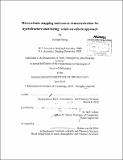Microseismic mapping and source characterization for hydrofracture monitoring : a full-waveform approach
Author(s)
Song, Fuxian
DownloadFull printable version (20.20Mb)
Other Contributors
Massachusetts Institute of Technology. Department of Earth, Atmospheric, and Planetary Sciences.
Advisor
M. Nafi Toksöz
Terms of use
Metadata
Show full item recordAbstract
The objective of this thesis is to improve the microseismic mapping capability for hydrofracture monitoring by using full-waveform information and understand fracturing mechanisms via microsesimic source mechanism inversion. First, we develop an array-based correlation approach to improve the detection of small magnitude events with mechanisms and locations similar to a nearby template event. Second, we extend the correlation detector to the subspace detector by including waveforms from multiple template events. Empirical procedures are presented for building the signal subspace from clusters of events. The distribution of the detection statistics is analyzed to determine subspace detection parameters. The benefits of the subspace detector are demonstrated on a dual-array hydrofracture monitoring dataset. Next, a full-waveform approach is developed for complete moment tensor inversion. By using synthetic data, we show that, for events in the near-field of a single monitoring well, a stable, complete moment tensor can be retrieved by matching the waveforms without additional constraints. At far-field range, we demonstrate that the off-plane moment tensor component is poorly constrained by waveforms recorded at one well. Therefore, additional constraints must be introduced. The complete moment tensor inversion approach is demonstrated with a single well dataset from the Bonner sands hydrofracturing. Moment tensor inversion results show that most events have a dominant double-couple component with the fracture plane orientation close to the average fracture trend derived from the multiple event locations. It suggests that in a reservoir with a high horizontal differential stress like the Bonner sands, the microseismicity occurs predominantly by shearing along natural fractures subparallel to the average fracture trend. Finally, the full-waveform based complete moment tensor inversion method is applied to a dual-array hydrofracture monitoring dataset in Barnett shale at Fort Worth Basin. The determined microseismic source mechanisms reveal both tensile opening on hydraulic fracture strands trending subparallel to the unperturbed maximum horizontal principal stress direction and the reactivation of pre-existing natural fractures along the WNW and N-S directions. Two main contributions are: 1) Improving hydrofracture mapping by developing advanced event detection and relocation algorithms using full waveforms; 2) Understanding the fracturing mechanisms through complete moment tensor inversion and geomechanical analysis.
Description
Thesis (Ph. D.)--Massachusetts Institute of Technology, Dept. of Earth, Atmospheric, and Planetary Sciences, 2013. Cataloged from PDF version of thesis. Includes bibliographical references.
Date issued
2013Department
Massachusetts Institute of Technology. Department of Earth, Atmospheric, and Planetary SciencesPublisher
Massachusetts Institute of Technology
Keywords
Earth, Atmospheric, and Planetary Sciences.